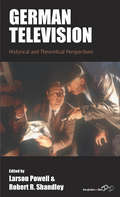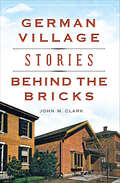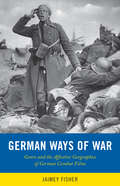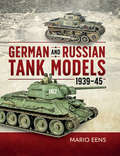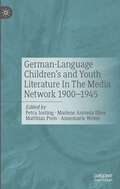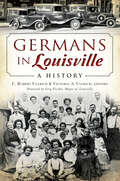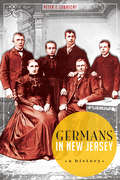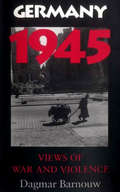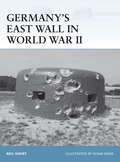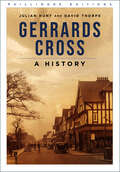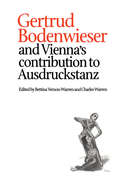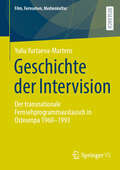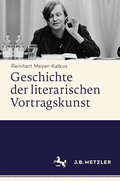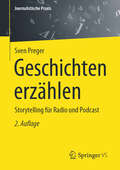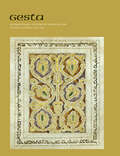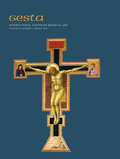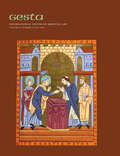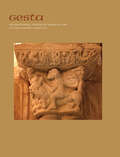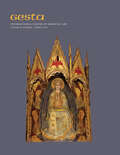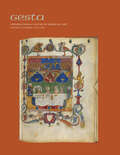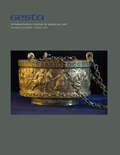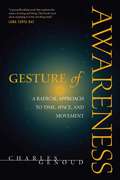- Table View
- List View
German Television: Historical and Theoretical Perspectives
by Larson Powell Robert ShandleyLong overlooked by scholars and critics, the history and aesthetics of German television have only recently begun to attract serious, sustained attention, and then largely within Germany. This ambitious volume, the first in English on the subject, provides a much-needed corrective in the form of penetrating essays on the distinctive theories, practices, and social-historical contexts that have defined television in Germany. Encompassing developments from the dawn of the medium through the Cold War and post-reunification, this is an essential introduction to a rich and varied media tradition.
German Village Stories Behind the Bricks (Landmarks)
by John M. ClarkExplore the rich history and mysteries of this Preserve America Community through the eyes of the people who live there! German Village's iconic homes, bustling businesses and other beloved sites harbor fascinating stories. Did you know that German Village's Recreation Park, now gone, is thought to have had the first baseball concession stand? Or that the four-story Schwartz Castle was the site of two murders? Or that the popular restaurant Engine House No. 5 closed its doors after the mysterious disappearance of its owners in the Bermuda Triangle? Longtime resident and tour guide John M. Clark goes behind the bricks of more than seventy German Village properties to explore the places and people who made the Old South End into a Columbus treasure.
German Wartime Memory, American Exceptionalism, and Post-Cold War Blockbuster Cinema (Popular Culture and World Politics)
by Robert PirroThis book excavates the diverse and mostly unnoticed political meanings made available to American and German audiences by the blockbuster films helmed by transplanted West German directors Roland Emmerich and Wolfgang Petersen.Through formal film analysis, broad consideration of American and German film criticism, and reflection on relevant political developments of the post-Cold War era, the book reveals how traces of Germany’s experience of dictatorship and wartime destruction find inadvertent cinematic expression in ways that helped American and German moviegoers find orientation in the changed political and cultural landscape of a newly globalized world. To complement and deepen the analysis of the Hollywood output of Emmerich and Petersen, the book juxtaposes the creative product of these transplanted directors to examples of a converse cinematic phenomenon considered under the label, American Babelsberg, which encompasses World War Two-themed films shot by American directors in Germany utilizing the production facilities at Babelsberg. Focus here is placed particularly on two high-profile cinematic releases of the aughts, Valkyrie (2008), and Inglourious Basterds (2009). The magnetic attraction to, or nettlesome burden of, World War Two memories on these directors of American Babelsberg and German Hollywood is explained in this book by the entwined histories of Germans and Americans, the different challenges of national self-definition and renewal they faced in the post-Cold War world, and their long-standing and ongoing transatlantic discourse of political ideas and cultural ideals.This book will be of great interest to students and scholars of film studies, politics, popular culture, and contemporary history.
German Ways of War: The Affective Geographies and Generic Transformations of German War Films (War Culture)
by Jaimey FisherGerman Ways of War deploys theories of space, mobility, and affect to investigate how war films realize their political projects. Analyzing films across the decades, from the 1910s to 2000s, German Ways of War addresses an important lacuna in media studies: while scholars have tended to focus on the similarities between cinematic looking and weaponized targeting -- between shooting a camera and discharging a gun – this book argues that war films negotiate spaces throughout that frame their violence in ways more revealing than their battle scenes. Beyond that well-known intersection of visuality and violence, German Ways of War explores how the genre frames violence within spatio-affective operations. The production of novel spaces and evocation of new affects transform war films, including the genre’s manipulation of mobility, landscape, territory, scales, and topological networks. Such effects amount to what author Jaimey Fisher terms the films’ “affective geographies” that interweave narrative-generated affects, spatial depictions, and political processes.
German and Russian Tank Models, 1939–45
by Mario EensThis fully illustrated guide offers step-by-step instructions for building detailed models of German and Russian WWII tanks. This comprehensive guide is invaluable for tank modelers of all skill levels. It includes tips and techniques for building models scaled at 1/72, 1/48 and 1/35. Expert modeler Mario Eens also provides a wealth of information on the tools, paints and techniques needed to give your models an accurate and realistic finish. With this guide at your side, you&’ll be able to recreate the Russian T-34 at the time of the battle of Kursk, and the Su-152 in winter camouflage, as well as the German Panzer I in North Africa, and the gigantic Maus, as it might have appeared just after the war ended.
German-Language Children's and Youth Literature In The Media Network 1900-1945.
by Petra Josting Marlene Antonia Illies Matthias Preis Annemarie WeberWith the research of German-language children's and youth literature and its media associations in the period from 1900 to 1945 as well as the recording of all data in an online portal for research and visual analysis, an innovative contribution to the historiography of children's and youth literature is available. The introduction provides information on the criteria for inclusion, central sources, theoretical frameworks, and the spectrum of the media associations investigated. Part I assembles three overview articles on the media of radio, film and theater for children and young people as well as a contribution on the conception and development of the online portal. In the second part, 18 selected media alliances are presented, sorted into the categories pioneers conquer the new media - stage children migrate to radio and/or film - fairy tales in film and radio - classics in all media - school stories in the theater, book and on the screen - crime and scandal on the screen - political conquers book and film.
Germans in Louisville: A History (American Heritage Ser.)
by C. Robert Ullrich and Victoria A. UllrichDiscover the German influence on the Derby City in this collection of historical essays. The first German immigrants arrived in Louisville nearly two hundred years ago. By 1850, they represented nearly twenty percent of the population, and they influenced every aspect of daily life, from politics to fine art. In 1861, Moses Levy opened the famed Levy Brothers department store. Kunz&’s &“The Dutchman&” Restaurant was established as a wholesale liquor establishment in 1892 and then became a delicatessen and, finally, a restaurant in 1941. Carl Christian Brenner, an emigrant from Lauterecken, Bavaria, gained notoriety as the most important Kentucky landscape artist of the nineteenth century. C. Robert and Victoria A. Ullrich edit a collection of historical essays about German immigrants and their fascinating past in the Derby City.
Germans in New Jersey: A History (American Heritage)
by Peter T. LubrechtGerman immigrants and their descendants are integral to New Jersey's history. When the state was young, they founded villages that are now well-established communities, such as Long Valley. Many German immigrants were lured by the freedom and opportunity in the Garden State, especially in the nineteenth century, as they escaped oppression and revolution. German heroes have played a patriotic part in the state's growth and include scholars, artists, war heroes and industrialists, such as John Roebling, the builder of the Brooklyn Bridge, and Thomas Nast, the father of the American cartoon. Despite these contributions, life in America was not always easy; they faced discrimination, especially during the world wars. But in the postwar era, refugees and German Americans alike--through their Deutsche clubs, festivals, societies and language schools--are a huge part of New Jersey's rich cultural tapestry.
Germany 1945: Views of War and Violence
by Dagmar Barnouw&“Packed with carefully chosen photos . . . this book is a moving reminder of the material and moral devastation left behind by Nazi Germany.&” ―Rudy Koshar, University of Wisconsin–Madison The Allied forces that entered Germany at the close of World War II were looking for remorse and open admissions of guilt from the Germans. Instead, they saw arrogance, servility, and a population thoroughly brainwashed by Nazis. But photos from the period tell a more complex story. In fact, Dagmar Barnouw argues that postwar Allied and German photography holds many possible clues for understanding the recent German past. A significant addition to the scholarship on postwar German culture and political identity, this book makes an important contribution to the current discussion of German memory. &“Provocative, brilliant, and unsettling.&” —Washington Times &“[Barnouw&’s] thoughtful analysis of a large assortment of photographs . . . allows Barnouw to look at how and not just what people saw, and to bring that perspective into conversation with the historical debates about the war&’s end in Germany.&” —Journal of Contemporary History) &“[Barnouw&’s] work shows that perspective plays a key role both in photography and in trying to master Germany&’s past. [F]ascinating.&” —Library Journal
Germany's East Wall in World War II
by Adam Hook Neil ShortThe East Wall was where the final battles for the stricken Third Reich were fought, amid scenes of utter carnage. Beginning life at the end of World War I, the wall became a pet project of Adolf Hitler's, whose ascent to power saw building work accelerated, with plans for a grand, 'Maginot-style' defence put in place. But with a characteristically erratic change of heart, Hitler began to systematically strip the wall of its best defensive assets to bolster the Atlantic Wall, never dreaming that he would face an attack on two fronts. Despite belated and somewhat bungled reinforcements later in the War, the Eastern Wall would face a monstrous challenge as it became the Reich's last redoubt in the face of the mighty Soviet war machine. Neil Short brings his expert knowledge to bear with an analysis of different stages of the wall's construction, the years of neglect and decay and the hasty, drastic redevelopment in the face of the looming Soviet threat.
Gerrards Cross: A History
by David Thorpe Julian HuntGerrards Cross, known for its open common and picturesque Latchmore Pond, had been a place of resort ever since the 1790s. Genteel houses sprang up, attracting enough wealthy visitors that it began to be known as the ‘Brighton of Bucks.’ The opening of the Great Western and Great Central Joint Railway in 1906, with a station at Gerrards Cross, gave hundreds of Londoners the opportunity to live in ‘Beechy Bucks.’Gerrards Cross: A History celebrates the energy and imagination of the pioneer architects, builders and estate agents who ensured that Gerrards Cross became a high-class residential area, both socially and architecturally. It also applauds the entrepreneurs who opened their new shops and services when the commuter houses were still on the drawing board, and the brave newcomers who brought their families to live in the country, but depended utterly on their reliable train service to London.
Gertrud Bodenwieser and Vienna's Contribution to Ausdruckstanz (Choreography and Dance Studies Series #18)
by Charles Warren Bettina Vernon-WarrenFirst Published in 1999. Routledge is an imprint of Taylor & Francis, an informa company.
Gervase Wheeler: A British Architect in America, 1847–1860 (The Driftless Connecticut Series)
by James F. O'Gorman Renee TribertGervase Wheeler was an English-born architect who designed such important American works as the Henry Boody House in Brunswick, Maine; the Patrick Barry House in Rochester, New York; and the chapels at Bowdoin and Williams colleges. But he was perhaps best known as the author of two influential architecture books, Rural Homes (1851) and Homes for the People (1855). Yet Wheeler has remained a little known, enigmatic figure. Renee Tribert and James F. O'Gorman's study sheds new light on the course of Wheeler's career in the states, and brings crucial issues to the fore--the international movement of ideas, the development of the American architectural profession, the influence of architectural publications on popular taste, and social history as expressed in the changing nature of the American house. Wheeler's career is traced chronologically and geographically and the book is lavishly illustrated with over fifty images, including building plans and historical photographs.
Geschichte der Intervision: Der transnationale Fernsehprogrammaustausch in Osteuropa 1960–1993 (Film, Fernsehen, Medienkultur)
by Yulia Yurtaeva-MartensDie Immanenz des internationalen Programmaustausches im Medium Fernsehen aufzuzeigen, ist das zentrale Anliegen dieses Bandes. Die Studie legt eine systematische Analyse der Entstehung, Entwicklung und Tätigkeit der Intervision vor, einer osteuropäischen – und aus heutiger Sicht transnationalen – Organisation, die 1960 zur Koordinierung des Fernsehprogrammaustausches ins Leben gerufen wurde. Den Schwerpunkt der Arbeit bildet die qualitative und quantitative Auswertung des Programmaustausches innerhalb der Intervision sowie deren Zusammenarbeit mit der westeuropäischen Eurovision unter Berücksichtigung der damaligen politischen und technologischen Rahmenbedingungen und Implikationen. Die analytische Betrachtung erstreckt sich dabei auf den gesamten Zeitraum des Bestehens der Intervision von 1960 bis 1993. Mit dieser umfassenden Untersuchung liefert der Band wertvolle Einblicke in die Mechanismen und Dynamiken des europäischen Fernsehprogrammaustausches in den Zeiten des Kalten Krieges und schließt an die gegenwärtige Forschung zum sozialistischen Fernsehen aus transnationaler Perspektive an.
Geschichte der literarischen Vortragskunst
by Reinhart Meyer-KalkusLiterarische Vortragskunst entstand in Deutschland in der zweiten Hälfte des 18. Jahrhunderts als ein von Schauspiel und anderen Vortragsgattungen (Rede, Predigt, Vorlesung etc.) unterschiedenes Sprachspiel des Vorlesens, Rezitierens und Deklamierens von Gedichten, Erzählungen und Dramen. Die vorliegende Untersuchung ist die erste umfassende Geschichte dieser Vortragskunst von Klopstock bis zu Kling, ja bis zum Poetry-Slam. Sie konzentriert sich auf die verschiedenen Akteure (Autoren, professionelle Rezitatoren, Deutschlehrer, Sprecherzieher und Laien) sowie auf deren Vortragsformate und Zuhörer im Kontext der Veränderung vortragsästhetischer Normen und mediengeschichtlicher Innovationen. Mit Rückgriff auf Einsichten der Medienwissenschaft, Performance-Analyse und Stimmforschung entwickelt sie einen analytischen Ansatz, um Vortragsformate und Vortragsweisen in ihrer Historizität zu beschreiben.
Geschichten erzählen: Storytelling für Radio und Podcast (Journalistische Praxis)
by Sven PregerEs gehört zu den schönsten und komplexesten Aufgaben in Podcast und Radio: spannende Geschichten zu erzählen. Wie kann ich Hörer*innen 15, 30 oder 60 Minuten an eine reale Geschichte binden? Oder gar für eine ganze Serie begeistern? Dieses Buch beschreibt den professionellen Weg zu einer spannenden Erzählung. Es gibt praxistaugliche Antworten auf alle entscheidenden Fragen: Welche Stoffe taugen für lange Geschichten? Wie halte ich die Spannung von Anfang bis Ende aufrecht? Wie finde ich meine Erzählstimme und klinge als Host natürlich? Und wie entwickelt man ein Sound Design für komplexe Erzählungen? Ein Praxis-Buch, mit dessen Hilfe sich die Potenziale von Podcast und Radio entfalten lassen. Die Website zum Buch bietet weiterführende Links und ergänzt aktuelle Entwicklungen. Für die zweite Auflage wurde der Band überarbeitet, aktualisiert und mit neuen Beispielen ergänzt.
Gesta, volume 60 number 2 (Fall 2021)
by GestaThis is volume 60 issue 2 of Gesta. Gesta publishes original research on medieval art and architecture. The journal embraces all facets of artistic production from ca. 300 to ca. 1500 C.E. in every corner of the medieval world.
Gesta, volume 61 number 1 (Spring 2022)
by GestaThis is volume 61 issue 1 of Gesta. Gesta publishes original research on medieval art and architecture. The journal embraces all facets of artistic production from ca. 300 to ca. 1500 C.E. in every corner of the medieval world.
Gesta, volume 61 number 2 (Fall 2022)
by GestaThis is volume 61 issue 2 of Gesta. Gesta publishes original research on medieval art and architecture. The journal embraces all facets of artistic production from ca. 300 to ca. 1500 C.E. in every corner of the medieval world.
Gesta, volume 62 number 1 (Spring 2023)
by GestaThis is volume 62 issue 1 of Gesta. Gesta publishes original research on medieval art and architecture. The journal embraces all facets of artistic production from ca. 300 to ca. 1500 C.E. in every corner of the medieval world.
Gesta, volume 62 number 2 (Fall 2023)
by GestaThis is volume 62 issue 2 of Gesta. Gesta publishes original research on medieval art and architecture. The journal embraces all facets of artistic production from ca. 300 to ca. 1500 C.E. in every corner of the medieval world.
Gesta, volume 63 number 1 (Spring 2024)
by GestaThis is volume 63 issue 1 of Gesta. Gesta publishes original research on medieval art and architecture. The journal embraces all facets of artistic production from ca. 300 to ca. 1500 C.E. in every corner of the medieval world.
Gesta, volume 63 number 2 (Fall 2024)
by GestaThis is volume 63 issue 2 of Gesta. Gesta publishes original research on medieval art and architecture. The journal embraces all facets of artistic production from ca. 300 to ca. 1500 C.E. in every corner of the medieval world.
Gesta, volume 64 number 1 (Spring 2025)
by GestaThis is volume 64 issue 1 of Gesta. Gesta publishes original research on medieval art and architecture. The journal embraces all facets of artistic production from ca. 300 to ca. 1500 C.E. in every corner of the medieval world.
Gesture of Awareness: A Radical Approach to Time, Space, and Movement
by Charles GenoudFrom a major mind of Buddhism today comes this unique philosophical work, which hearkens back to the classical verse-form, but in a modern voice that speaks directly to the twenty-first century reader and practitioner. Gesture of Awareness involves a fascinating philosophical exploration of time, space, and movement but at the same time is a manual for an embodied "practice of exploration." Genoud is very well known to the leading lights of Buddhism today. He and his work are continuingly praised for their invention and importance. Well-versed in French and continental philosophies, as well as Eastern thought, he has produced a work that will be welcomed as a Buddhist book and a noteworthy contribution to the larger philosophical community.
